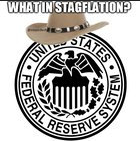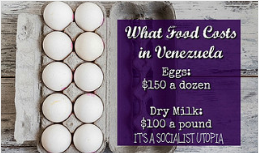Stagflation to take down Keynesians Again
Since 2009, it’s been all Keynes, all the time, with then Fed Chair Ben S. Bernanke named TIME Magazine’s Person of the Year for saving the financial system with enough brute force printing and guaranteeing to make Lord Keynes himself shake his head.
Other than a scattered Austrian here and there, Bernanke and his successor Janet Yellen went about their business unquestioned. Quantitative Easing (QE) was the Keynesian magic wand that kept the ATMs operating on time. And, according to government figures price inflation was nowhere to be found. Indeed, it seemed, a free monetary lunch could be had.
Now, Danielle DiMartino Booth, author of "Fed Up," and scheduled speaker at an upcoming Mises Institute Event in Fort Worth Texas, writes for Bloomberg, “Markets Better Prepare for Stagflation.”
Of course, Keynesians believe stagflation can’t happen. Higher prices and slow growth don’t happen concurrently. Growth fueled by wise government intervention will lead to higher prices and those high prices signal government to hit the breaks which lead to lower prices and slower growth. Rinse, Wash, Repeat ad nauseum.
DiMartino Booth writes,
According to producers, input costs have risen for six of the past eight months. And it’s not just big companies that are feeling pressure. One in four small businesses say they plan to raise prices, a 10-year high, according to the National Federation of Independent Business. Inflation’s persistence will finally begin to trickle through to consumers.
In my little corner of commerce, homebuilding in the Las Vegas area, our subcontractors and suppliers have raised prices constantly for the past six months. When the word “tariff” is on the tip of Trump’s tongue, everyone raises their prices. To this point, my employer has been able to pass the costs on to homebuyers.
The former Dallas Fed analyst writes that our experience is typical. “Evidence of ‘panic buying’ -- that is, buying in anticipation of potential price hikes that could occur as a result of tariffs -- arrived with the first releases of regional April manufacturing surveys.”
David Rosenberg, chief economist at the wealth management company Gluskin Sheff, says we “better say a prayer for Jay Powell,” Yellen’s replacement as Fed chair.
“I see 50/50 odds of a 3 percent core inflation by year end,” says Rosenberg.
At the same time, Ms. DiMartino Booth sees problems everywhere with economic growth. “The six-month business activity outlook dove to 18.8 from 44.1, the weakest since February 2016,” she writes. “the 26-point move lower is worse than anything seen during the 2008-09 financial crisis and on par only with the one that followed Sept. 11.”
Meanwhile, retaliation for Trump’s tariffs will likely hit agriculture, manufacturing and transportation industries hard.
In the ongoing battle for the hearts and minds in academia, there could be an upside to stagflation. Murray Rothbard, in “For A New Liberty” (first published in 1973), wrote the Austrian school was barely kept alive for four decades until the stagflation in the 1970’s debunked Keynesian theory.
He wrote, “Surely, it is no accident that the current renaissance in Austrian economics has coincided with the phenomenon of stagflation and its consequent shattering of the Keynesian paradigm for all to see.” In 1974, F.A. Hayek shared the Nobel Prize.
DiMartino Booth closes with, “Rising prices and collapsing confidence could portend that both inflation and slowing growth are looming, a sure recipe for stagflation.”
This will drive yet another stake into the heart of Keynesian theory which refuses to die.






